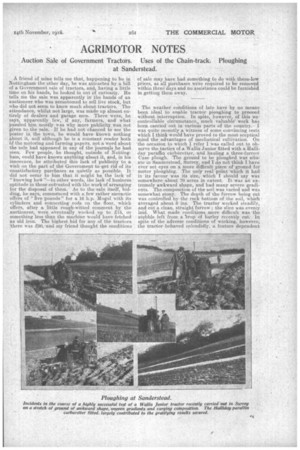AGRIMOTOR NOTES
Page 19

Page 20

If you've noticed an error in this article please click here to report it so we can fix it.
Auction Sale of Government Tractors. Uses of the Chain-track. Ploughing at Sand erstead.
A friend of mine tells me that, happening to be in . Nottingham the other day, he was attracted by a bill of a Government sale of tractors, and, having a little time on his hands, he looked in out of curiosity. He tells me the sale was apparently in the bands of an auctioneer who was accustomed to sell live stock, but who did not seem to know much about tractors. The attendance, whilst not large, was made up almost entirely of dealers and garage men. There were, he says, apparently few, if any, farmers,. and what puzzled him mostly was why more publicity was not given tothe ,.sale. If he had not chanced to see the poster in the town, he would have known nothing about it, and although he is a constant reader both Of the motoring and farming papers, not a word about the sale had appeared in any of the journals he had seen. Few people, he thought, outside of Nottingham, could have known anything about it, and, in his innocence, he attributed this lack of publicity to a wish on the part of the Government to .get rid of its unsatisfactory purchases as quietly as possible. It did not occur to him that it might be the lack of "knowing ho W "—in other words, the lack of business aptitude in those entrusted with the work of arranging for the disposal of them. As to the sale itself, bidding, he says, commenced with a few rather sarcastic offers of "five pounds" for a, 16 h.p. Mogul with its cylinders and connecting rods on the floor, which offers, after a little rough-witted comment by the auctioneer, were eventually worked up to £15, or something less than the machine would have fetched es old iron. The highest bid for any of the tractors there was 290,'and my friend thought the conditions
of sale may have had something fo do with these,low prices, as all purchases were required to be removed within three days and no assistance could be furnished in getting them away.
The weather conditions of late have by no means been. ideal to enable tractor ploughing to proceed without interruption. In spite, however, of this -uncontrollable circumstance,, much valuable' work has been carried' out in various parts of the country. I was quite recently a witness of some convincing tests which I think would have proved to the most sceptical mind the advantages of mechanical cultivation. On 'the occasion to which I refer I was called out to observe the tactics of a Wallis Junior fitted with a Halliday paraffin carburettor, and hauling a three-furrow Case plough. The ground to be ploughed was situate in Sanctorstead, Surrey, and I do not think I have ever set eyes on a more difficult piece of ground for motor ploughing. The only real point which it had in its favour was its size, which I should say was somewhere about 70 acres in extent. It -was an extremely awkward shape, and had many severe gradients. The composition of the soil was varied and was somewhat stony. The depth of the furrow being cut was controlled by the rock bottom of the soil, which averaged about 6 ins. The tractor worked steadily, and cut a clean, straight furrow ; the slice was evenly laid. What made conditions more difficult was the stubble left from a *crop of barley recently cut. ln spite of the adverse conditions of working, however, the tractor behaved splendidly, a feature dependent
to a very great extent upon the efficiency of the Halliday carburetter. The running of the engine on paraffin did not affect its power, and in fact it was impossible to tell that paraffin was being burned. The illustrations on the previous page show in limited form the nature of the difficulties encountered..
One very remarkable fact presents itself as part' of the experience of the war and that is the way in which the chain-track system of construction, first developed in connection with the agricultural tractor, has come to the front. Not only are chain-traci tractors now almost exclusively used in connection with the artillery haulage work, which is slow-moving work with heavy loads, but the chain track is used exclusively in the conhtruction of the movable land fortresses known as "Tanks." They have latterly been employed in connection with the construction of comparatively light armoured cars, following Tank lines, in which speeds not far off 20 miles an hour are employed. This fact is very important evidence that this system of construction is not.necessarily confined to slow-moving outfits, and this opens up great possibilities for • after-the-war development in commercial motor transport on the road. Hitherto, the understood lack of speed has been one of the chief preventives of any attempt at development in this direction. Another cause has been the wear on the chain treads on hard roads ; but this, I feel sure, can and will eventually be removed by improved design of the tread shoes and connections and by the employment of special alloy steels in their
tion. AGRIMOT.






















